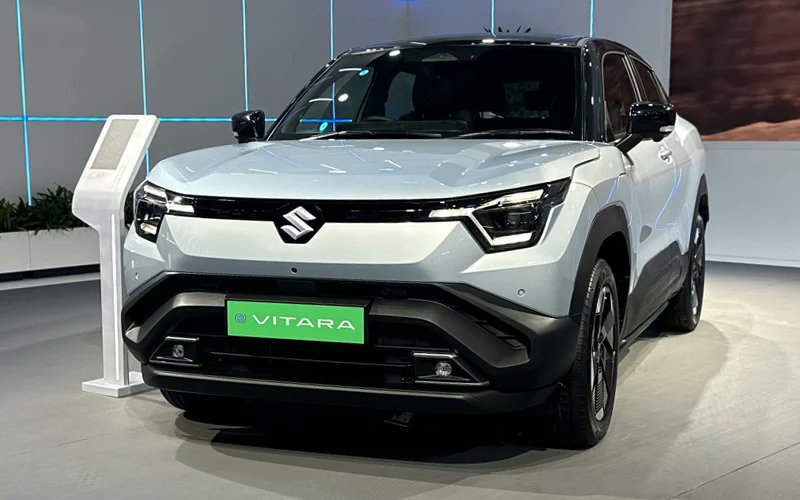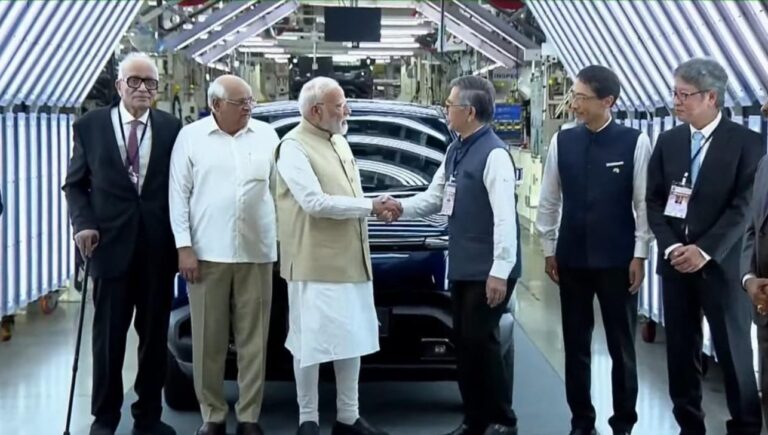Prime Minister Narendra Modi’s announcement of the Green Mobility Plan, which aims to revolutionize the country’s transportation system, marked a significant step towards a cleaner future for India. At its heart is the E-Vitara project, a mass-market electric SUV designed to make eco-friendly mobility affordable for millions of Indians.
New Delhi, August 26, 2025 — India entered a new chapter in its journey towards sustainability as Prime Minister Narendra Modi formally unveiled the Green Mobility Plan on Tuesday. The nationwide program, focused on electric vehicles, hydrogen power, ethanol, and smart transport, aims to reshape India’s transportation sector by 2030.
The highlight of the launch was the much-anticipated E-Vitara Project — India’s first mass-market electric SUV manufactured by Maruti Suzuki in partnership with the government under the Make in India initiative. With promises of affordability, long range, and cutting-edge technology, the E-Vitara is being positioned as the “people’s EV,” potentially democratizing access to electric mobility in a way India has never seen before.
Why Green Mobility, Why Now?
India, the third-largest greenhouse gas emitter in the world, has a difficult task ahead of it. With rapid urbanization, a booming automobile market, and rising demand for energy, transport has become both an economic enabler and a serious environmental threat.
Pollution crisis: According to the World Air Quality Report (2024), 14 of the world’s 20 most polluted cities are in India, with vehicular emissions contributing up to 30% of urban air pollution.
Oil dependency: India imports nearly 85% of its crude oil, spending billions of dollars annually, which strains foreign reserves.
Public health: The Indian Council of Medical Research estimates that air pollution contributes to over 1.7 million premature deaths annually.
Against this backdrop, the Green Mobility Plan has been described as not just an economic policy but a public health and climate survival strategy.
PM Modi emphasized this urgency, stating:
“Every electric car sold, every biofuel crop grown, every green bus on the road—each of these is a step towards saving lives and ensuring energy freedom for India.” Today is a special day in India’s towards self-reliance and becoming a hub of green mobility. A the event in Hansalpur, the e-vitara will be flagged off. THis battery electric vehicle is manufactured in india and will be exported to over 100 countries. To boost our battery ecosystem, production of hybrid battery electrodes will also begin at a plant in gujarat.
The Green Mobility Plan: A Roadmap to 2030
The initiative is designed with clear milestones for the next decade:
1. By 2027:
- 10,000 charging stations installed along national highways.
- 50% of new city buses electrified.
- Launch of hydrogen pilot projects in five major metros.
2. By 2030:
- At least 30% of all new private vehicle sales to be electric.
- 80% electrification of two-wheelers and three-wheelers.
- Nationwide ethanol blending at 25%.
- Complete transition of public bus fleets in 100 smart cities to electric power.
The E-Vitara Project: India’s People’s EV
The showstopper of the launch event was undoubtedly the E-Vitara SUV, revealed amidst loud applause and camera flashes. Developed jointly by Maruti Suzuki’s R&D team and India’s Ministry of Heavy Industries, the E-Vitara represents the country’s ambition to provide world-class electric mobility at an affordable price point.
Development Journey
The project began in 2021, when the government announced a special EV innovation fund to support local manufacturers. Maruti Suzuki, India’s largest carmaker, took up the challenge, investing ₹20,000 crore in EV R&D and battery production plants in Gujarat and Haryana. The first prototype rolled out in late 2023, and after two years of testing, the model is now ready for mass production.
Technical Highlights
- Battery & Range: 72 kWh battery pack, offering up to 550 km range per charge.
- Charging: Ultra-fast charging support, delivering 80% charge in 40 minutes.
- Performance: 0–100 km/h in 8.5 seconds, designed for both highways and rugged terrains.
- Safety: 5-star Global NCAP rating, with ADAS (Advanced Driver Assistance Systems).
- Smart Features: Over-the-air software updates, AI-based driver assist, app-based climate control.
- Eco Materials: Recycled plastics and sustainable interiors to reduce lifecycle emissions.
Affordability and Target Market
The E-Vitara is expected to be priced at ₹15–18 lakh, making it one of the cheapest long-range EV SUVs in the global market. Its affordability is central to the government’s plan to encourage middle-class adoption.
Transport Minister Nitin Gadkari noted:
“The E-Vitara is designed for India—for its roads, for its families, and for its aspirations. Just as the Maruti 800 brought mobility to every household in the 1980s, the E-Vitara will bring green mobility to every household in the 2020s.”

How the E-Vitara Compares Globally
The SUV has already drawn comparisons with global EV models like Tesla Model Y, BYD Atto 3, and Hyundai Kona Electric. While Tesla dominates premium EV markets, the E-Vitara is positioned as “the affordable EV for emerging markets.”
- Tesla Model Y: ₹45–50 lakh (imported), range ~530 km.
- BYD Atto 3: Range ~480 km, price ~₹33–34 lakh.
- E-Vitara: Range ~550 km, price ₹15–18 lakh (locally made).
Analysts say this cost-performance balance could allow India not just to meet domestic needs but also to become a major exporter to Africa, Southeast Asia, and Latin America.
Public Health and Environmental Impact
If implemented successfully, the Green Mobility Plan could:
- Cut India’s oil import bill by $60 billion annually by 2030.
- Reduce annual CO₂ emissions by 200 million tonnes.
- Reduce urban air pollution, which might save hundreds of thousands of lives annually.
Doctors and health experts have already welcomed the plan. Dr. Randeep Guleria, former AIIMS Director, remarked:
“Cleaner air will reduce cases of asthma, lung disease, and cardiac issues. The benefits of green mobility are not just environmental but directly health-related.”
Voices from Rural India
Unlike many policies that remain city-centric, the Green Mobility Plan also prioritizes rural mobility. Farmers are set to benefit from ethanol and biofuel demand, while subsidized e-rickshaws and solar-charged two-wheelers aim to improve connectivity in villages.
Prakash Jadhav, a sugarcane farmer from Maharashtra, expressed optimism: “For years, we’ve struggled with falling sugar prices. If ethanol blending increases, it will create steady demand and better incomes for us.
Expert & Industry Reactions
Automobile Industry: SIAM predicted a surge of new EV startups in India.
Economists: According to NITI Aayog analysts, the program may generate 5 million new jobs by 2035.
Environmentalists: While applauding the initiative, organizations such as Greenpeace India called for stricter laws pertaining to the integration of renewable energy sources and battery recycling.
Challenges to Watch
Despite the excitement, experts caution that challenges loom:
1. Infrastructure Gap: Charging networks in rural and semi-urban India remain inadequate.
2. Battery Recycling: Without a strong ecosystem, India could face a “lithium waste crisis.”
3. High Initial Cost: Despite being cheaper than global EVs, the E-Vitara may still be costly for lower-income groups.
4. Energy Source: If EVs run on coal-generated electricity, emissions may simply shift from vehicles to power plants.
5. Transition for Workers: Millions employed in petrol pump networks, oil refining, and ICE vehicle parts manufacturing will require retraining.
India in the Global Green Mobility Race
Globally, countries are accelerating EV transitions:
- The EU plans to phase out petrol and diesel cars by 2035.
- China is already the world’s largest EV manufacturer, exporting to Europe and Asia.
- The US has set ambitious EV adoption targets backed by the Inflation Reduction Act.
By launching the Green Mobility Plan and the E-Vitara, India signals its intention to not only catch up but to lead in affordable EV innovation.
The Road Ahead
The government has set 2025–2030 as a “decade of transformation.” With the E-Vitara rolling into showrooms by early 2026, India’s streets may soon look and sound different—quieter, cleaner, and greener.
PM Modi closed the event with a vision statement:
“The Green Mobility Plan and E-Vitara are more than policies and cars—they are promises to our children, that the India of tomorrow will breathe easier, live healthier, and stand taller on the world stage.”
Related News: Read More




Pingback: 40% GST Hike to Make Premium Motorcycles Costlier in India